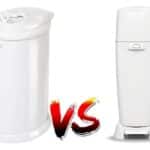Pacifiers can be every new mom’s best friend. Sometimes nothing will stop your baby from crying, pop in a pacifier and suddenly peace is restored.
It is a personal choice whether to give your baby a pacifier or not but there is no denying that pacifiers are a great tool to have when it comes to easily soothe your baby.
This is not the case for all babies though. To the dismay of exhausted parents, not all newborns will accept a pacifier and it can take a lot of time and patience to encourage your baby to keep a pacifier in their mouth.
Are you up and down all night popping your baby’s pacifier back in? Does your newborn spit their pacifier out or refuse to suck on it at all? If all you want is five minutes’ peace, it can be frustrating when your newborn won’t keep a pacifier in their mouth.
Don’t panic dear exhausted parent. This article is full of tips and hacks on how to keep a pacifier in a newborn’s mouth.
Why Can’t My Baby Hold a Pacifier In Her Mouth?
Do you ever feel like every other baby you see is happily sucking on a pacifier and yours is the only one who refuses to keep one in their mouth?
You are not alone. It is really common for babies to refuse a pacifier, and it can take some much longer than others to learn how to hold the pacifier in their mouth.
Let’s take a look at some of the reasons why your baby won’t keep a pacifier in its mouth:
They don’t like the texture of the nipple
Even a soft silicone pacifier nipple will not feel exactly like mom, no matter what the packaging may claim. Of course, a pacifier with a soft silicone nipple will feel more natural than tougher firmer plastic but it is no constellation for the real thing.
Your baby may be refusing a pacifier simply because it does not feel the same as your breast in their mouth. If your baby is used to nursing, it may take a little longer for them to happily suck on a pacifier and keep it in their mouth.
The pacifier is the wrong size or shape
View in gallery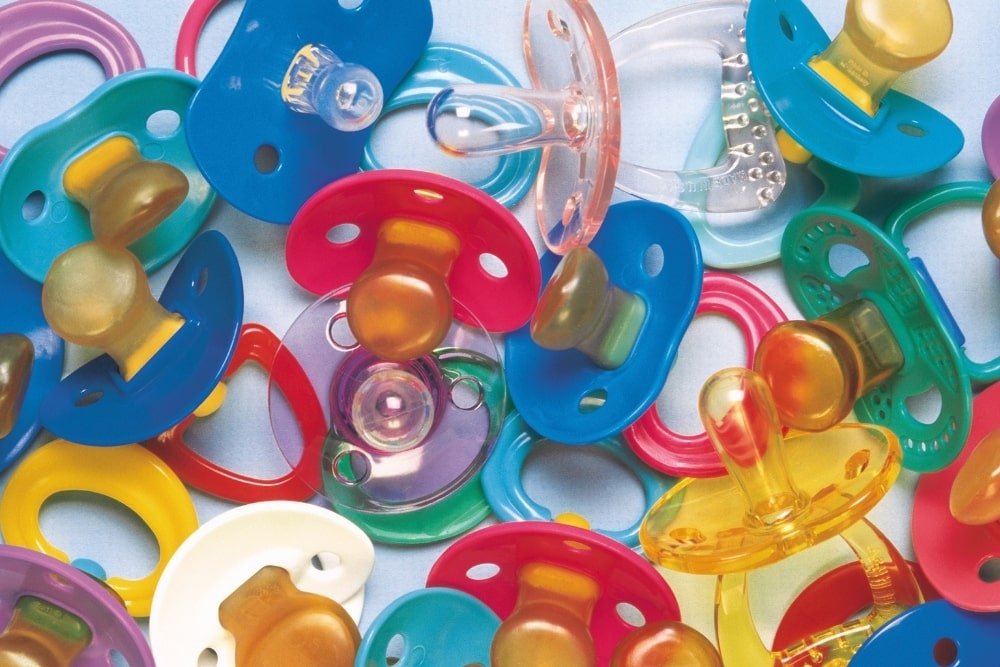
Pacifiers come in all different shapes and sizes. There are short nipples, long nipples. flat nipples, cherry-shaped nipples, and nipples that move and flex as your baby sucks.
The size of pacifiers also varies and you can buy pacifiers for newborns, pacifiers for 0-6month old babies, and pacifiers suitable for older babies and toddlers.
If your baby is refusing a pacifier it may be because it is the wrong size or shape to fit comfortably in their mouth. If the pacifier nipple is not the right shape or size for your baby’s mouth, they may not be able to suck on it as effectively and this could be the reason it keeps dropping from their mouth.
Your baby is hungry
When your baby is hungry they do not want a milkless pacifier put in their mouth, they want to nurse or have their bottle.
If you keep trying to give your baby a pacifier when they are hungry they are much more likely to spit it out than if you offered the pacifier after a feed.
Pacifiers can comfort and soothe a baby but they don’t fill up their tummies when they are hungry. Give your baby a feed and try offering the pacifier again, they may accept it more easily now that they don’t want any milk.
Your baby has a weak suck
Some babies are born with strong sucking action and others are not. If your baby was premature they may take a little while longer to build up the strength they need in their mouth and jaw to be able to suck and keep a pacifier in their mouth.
Sometimes a baby can’t keep a pacifier in their mouth because they haven’t mastered the sucking skill yet and they need to increase their muscle strength and tone first.
Your baby can’t put the pacifier back in
Pacifiers pop out sometimes, it happens. Maybe your baby yawned, or cried, or accidentally pushed the pacifier out with their tongue.
Some parents may not realize how often their baby’s pacifier is falling out because the baby is able to pick it up and put it back in themselves.
Good fine motor skills are needed for babies to be able to do this and it is very unlikely your newborn will be able to put their pacifier back into their mouth when it falls out.
However, older babies should be developing their fine motor skills and if your baby can’t put their soother back in their mouth, it may be because they need a little more time to improve their coordination and fine motor skills.
View in gallery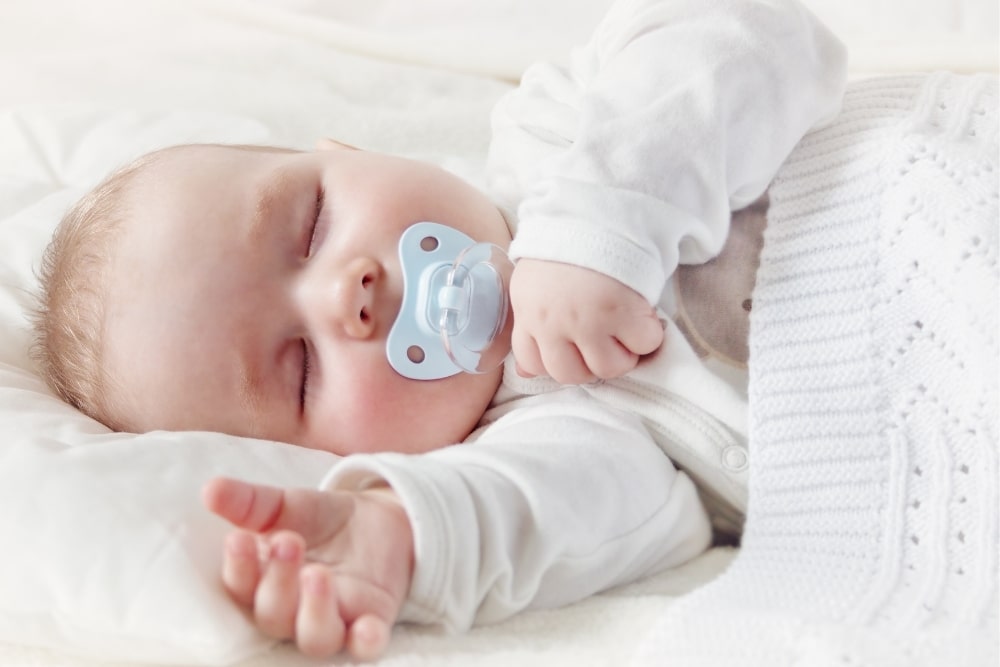
How To Keep Pacifier In Newborn’s Mouth
Babies are all unique and follow their own path when it comes to their development. If your baby is struggling to keep a pacifier in their mouth, don’t worry.
There are lots of different things parents can try which will encourage their baby to suck on their pacifier and keep it in their mouth for longer. Here is a list of tips on how to keep a pacifier in your newborn’s mouth:
Give the pacifier when your baby is content
Trying to give your baby a pacifier for the first time when they are upset or hungry is not going to end well. If your baby wants food they will continue to spit the pacifier out until they get the milk they want.
If your baby is too upset they may be crying too much to suck on the pacifier and keep it in their mouth. You want your baby to practice their pacifier sucking skills when they are calm and happy. Try offering a pacifier after a feed or when your baby is happy in your arms.
Give your baby time to practice sucking
It can take time for some babies to build up enough strength in their mouth to effectively suck on a pacifier for a prolonged period of time.
Offer your baby their pacifiers regularly throughout the day so they have the opportunity to practice their sucking skills. The stronger your baby’s suck, the easier it will be for them to keep the pacifier in their mouth for longer.
Try different pacifiers
There is not one pacifier that every baby is guaranteed to accept. If your newborn can’t keep a pacifier in their mouth, then perhaps that pacifier is not the one for them.
A nipple that is too large or too short can be difficult for your baby to keep in their mouth, maybe it is time to try a different pacifier brand. It is not unheard of for parents to buy every pacifier in the store before finding one that their baby will happily keep in their mouth.
Some Highly Rated Pacifiers From Amazon:
| Image | Title | Price | Prime | Buy |
|---|---|---|---|---|
Top | MAM Start Newborn Pacifiers (2 pack, 1 Sterilizing Pacifier Case) | PrimeEligible | Buy Now | |
 | Itzy Ritzy Sweetie Soother Pacifier Set of 2 | PrimeEligible | Buy Now | |
 | Philips Avent Soothie Pacifier, Blue, 0-3 Months, 4 Pack | PrimeEligible | Buy Now |
Try reverse psychology
View in gallery
If you want to help your baby to learn to keep a pacifier in their mouth, a little bit of reverse psychology might just do the trick.
Instead of always pushing the pacifier into your baby’s mouth and waiting for it to fall out, try putting the soother in your baby’s mouth and gently pulling it when they are sucking.
The desired outcome to this will be that your baby begins to suck harder to keep the pacifier in their mouth. This little game will encourage your baby to suck harder on their pacifier to keep it in their mouth.
By gently pulling the pacifier as soon as your baby accepts it, you will be helping your baby to learn what they need to do when they feel the pacifier slipping from their mouth.
Your baby will learn how to suck more effectively and this exercise will improve the strength and muscle tone they need for sucking.
Your baby doesn’t want a pacifier
This isn’t really a tip, it is just a fact. Some babies will not accept a pacifier or keep one in their mouth for more than a couple of minutes, no matter how hard you try.
If you have tried all of the tips above and your baby continues to spit out their pacifier, maybe you need to just accept your baby doesn’t like pacifiers.
Giving your baby a pacifier is not the only way you can soothe and comfort them, there are lots of other ways you can calm your baby. Try giving extra hugs, nursing for comfort, offering a comfort blanket or a soft toy, singing a lullaby, there are lots of ways you can calm your baby without a pacifier.
Can You Leave A Pacifier In Baby’s Mouth While Sleeping?
Once your baby has mastered keeping the pacifier in their mouth, you may be wondering if it is safe to leave the pacifier in your baby’s mouth while they are sleeping.
Pacifiers can be a great tool in helping your baby drop off to sleep and stay asleep for longer. You may be concerned about the safety of pacifiers at bedtime, here is a list of the key information you need to know about letting your baby have a pacifier while they sleep:
Pacifiers can reduce SIDS
Several studies have found that babies who suck on a pacifier while sleeping have a reduced risk of dying from SIDS (Sudden Infant Death Syndrome).
The actual reason why pacifiers reduce the risk of SIDS is still unclear but studies have found a very clear correlation between pacifier use and the risk of SIDS.
View in gallery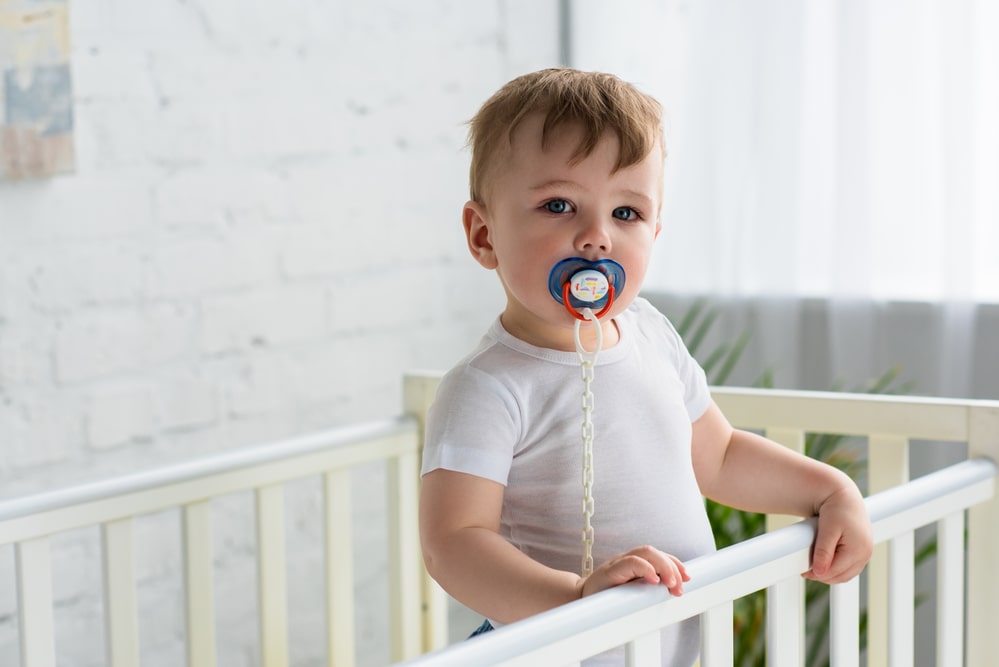
Use a pacifier with air vents
It is best to always use a pacifier that promotes easy air circulation, often there will be holes or large empty spaces in the face of the pacifier. Using a pacifier that has space for air to flow more naturally around your baby’s mouth and nose makes using a pacifier even safer at bedtime.
Some pacifiers have faces made of thick large pieces of plastic that can get in the way of your baby’s nose, especially in certain sleeping positions.
Your baby won’t be smothered by their pacifier in their sleep but it is always a good idea to use a pacifier that encourages normal airflow and air circulation while your baby sucks in their sleep.
Use a one-piece pacifier
There are pacifiers available to buy on the market that is made of one piece of soft silicone. These pacifiers are the safest option for bedtime sleep as you will not have to worry about any nipples coming loose from the pacifier face.
One-piece pacifiers are designed so no parts can separate and potentially cause choking.
Do not attach a pacifier to a baby
Pacifier strings and clips can be extremely useful when out and about with your baby. By attaching your baby’s pacifier to their clothes with a string, if your baby spits it out it can’t get lost.
However, using a string to stop your baby from losing their pacifier at night can be really dangerous. Pacifier clips and strings pose a risk of strangulation if your baby uses one in their sleep.
If your baby is prone to spitting their pacifier out at night, buy a glow-in-the-dark pacifier that you (or your baby) can easily locate if it falls from their mouth during the night.
You can allow your baby to use a pacifier while sleeping, just make sure you are following these safety guidelines. Many babies use a pacifier to get to sleep and to stay asleep during the night.
It is important to be aware though, if your baby can’t keep the pacifier in their mouth for long, you may be making several trips back and forth to the nursery all night to keep popping the pacifier back in.
FAQs
View in gallery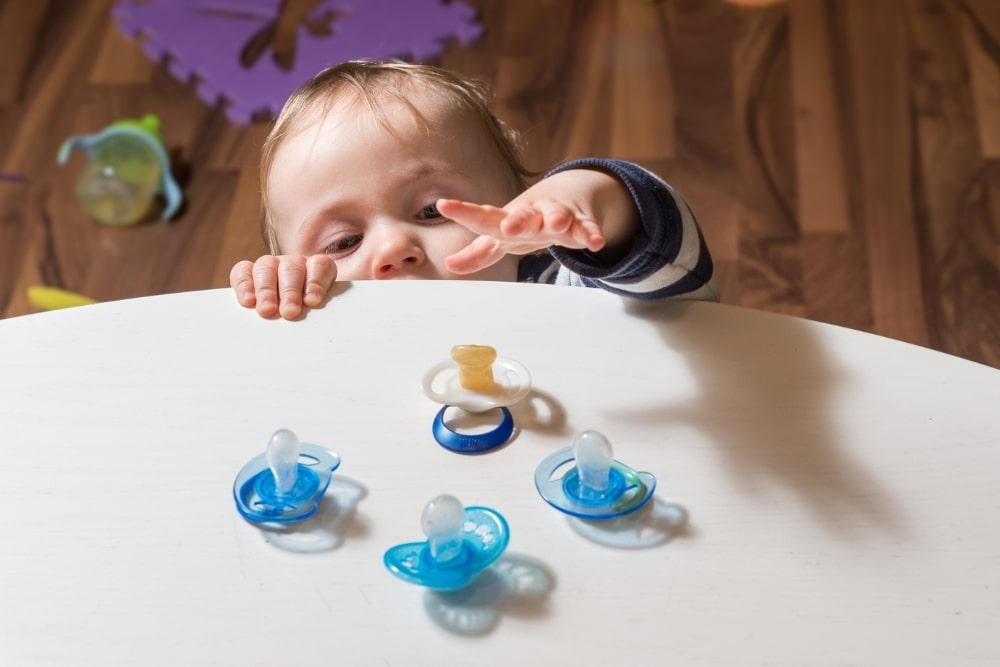
How often should you change a pacifier?
Pacifiers should be replaced every two months depending on how much they are used and the material that they are made from. Pacifiers should be examined closely regularly to check for any wear and tear.
Does pacifier shape matter?
It may seem like a very small detail in the grand scheme of things but it can make the difference between your little one happily accepting their pacifier and them constantly spitting it out. It can also make a difference to their oral health and wellbeing.
What is the best pacifier shape?
Once your baby reaches around 6 months old and their teeth begin to emerge it is advised that you use an orthodontic shaped pacifier. This shape is the least likely to alter the shape of your baby’s gum line.
The Final Thought
Learning to suck on a pacifier can be a hard skill for some babies to perfect. If you have been despairing and wondering how you can get a pacifier to stay in a newborn’s mouth, we hope you have found the answers you need in this article. For more tips check out our other tips here.
Your baby may be a member of the no pacifier club and that’s ok, not all babies like them. However, if your newborn keeps spitting their pacifier out, there are lots of tips and tricks you can try to encourage them to keep that pacifier in. Good luck!
If you have cracked the keeping the pacifier in your newborn’s mouth and are now wondering how many pacifiers do you actually need, check out our article here.






